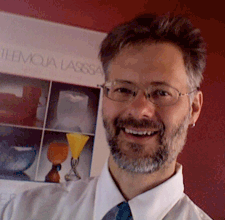Pilgrim Reindeer in Pisa, 1348
a free multimedia novel by
Thomas A. DuBois, University of Wisconsin-Madison
 |
Pilgrim Reindeer in Pisa, 1348 a free multimedia novel by Thomas A. DuBois, University of Wisconsin-Madison |
|
|
|
Part III. Italy. 46. San Gimignano [March 12, 1348]
For me, this chapter is a key hinge moment in the overall narrative: an occurrence of a putative miracle that can be interpreted in any of three ways: as a mere accident, and instance, of shamanic spirit help, or a case of saintly intercession. In the legends narrated about magical guarding of livestock and goods, narrators never suggest that the thief got his hand tangled up in reins: rather, the thief's hands are simply magically glued to the animal or object until the next morning, when the rightful owner releases the thief. In writing the chapter, however—as in the novel as a whole—I wanted to keep each of these three explanatory modes operative without necessarily privileging one set of explanations over the other two. The novel is told through Bávlos's eyes, but Bávlos himself is unclear about the interrelation of these different explanations. Thus, I hoped to make the chapter as open-ended and ambiguous as possible. At the same time, I wanted to underscore the pain of both the Passion and the thief's situation to suggest that Bávlos, as a newcomer to the faith, is not jaded about any of the stories he is hearing: for him, the notion of the torture and pain of the Crucifixion is vivid and real and he views the betrayal and abandonment of Jesus by his disciples with horror. These are feelings that help motivate his later actions in coming chapters.